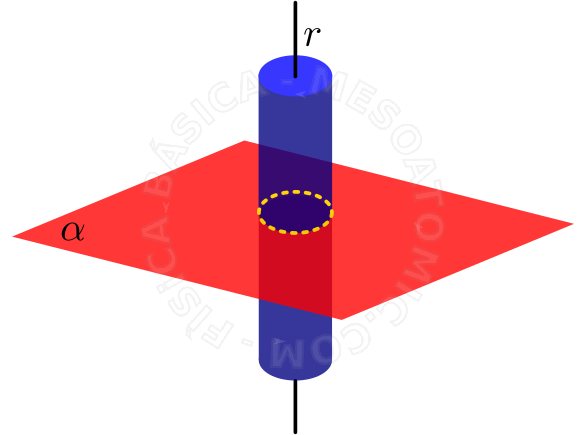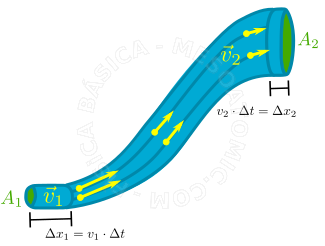- Fluids
- /
- Hidrodinamic
- /
- Volumetric flow rate
Fluid Dynamics (Hydrodynamics) is the study of moving fluids (liquids and gases). For example, the flow of water into a pipe, the blood flowing through a person's arteries, the flow of air through airplanes and cars, weather phenomena, etc.
Ideal Fluid Model
If we can consider a fluid to be ideal, the equations governing flow can be simplified.
The ideal fluid has four characteristics:- Incompressible Fluid
- Density never changes. Liquids in general satisfy this condition. Gases do not.
- Non-Viscous Fluid (Invisible)
- It is the fluid whose viscosity is small enough to be ignored. The higher the viscosity, the greater the difficulty for the fluid to flow. Viscosity is a resistance to flow, is analogous to kinetic friction. It is an easier assumption to obtain with gases than with liquids in general.
- Laminar flow
- It is characterized by smooth chain lines and highly ordered movement, and is turbulent when it has fluctuations of speed and highly disordered movement.
- Stationary flow
- The velocity of the fluid at each point thereof is constant over time.
Describing Flows

Flows can be described by current lines:
- The path followed by a "fluid particle" is called the current line.
- Neighboring chain lines constitute a pipe of current lines.
Properties of current lines:
- Chain lines never cross.
- The velocity of the particle in the fluid is tangent to the current line.
- The speed is higher where the current lines are closer.
FLOW RATE
To understand the concept of flow, one must first remember the definition of straight section. See figure.

There are two types of flow:
- Volumetric Flow \ ((Q_vol) \)
- It is called a volumetric flow the volume of the flowing fluid, through a straight section, per unit of time. The volumetric flow \(Q_{vol}\) in a tube having a straight cross-section of area A is the time rate at which a volume of fluid passes through this section. Mathematically we have: $$Q_{vol} = \frac {\Delta V} { \Delta t}= \frac{A \cdot \Delta x} { \Delta t} = A \cdot v, $$ where \(A \) the cross - sectional area of flow, \(\Delta V\) the volume traversed \ (a \) in the time interval \ (\ Delta t \) and \( v \) is the particle velocity of the fluid.
- Mass Flow \ ((Q_m) \)
- The mass \(\Delta m\) of the fluid flowing through a straight section over a time interval \(\Delta t\) is called the mass flow, $$Q_{m} = \frac {\Delta m} { \Delta t} = \frac{ \rho \Delta V} { \Delta t} = \rho A v , $$ being \(\rho\) fluid density, \(A\) to the cross - sectional area fluid and \(v\) is the velocity of the particles of the fluid.
When we adopt a cross section, other than straight, the flow will depend on how this section is positioned in relation to the direction of the fluid velocity.
EQUATION OF CONTINUITY

When an incompressible fluid flows through a tube, the law of conservation of mass requires that the amount of fluid in volume or mass entering the tube is equal to leaving the tube. That is, the product of the cross-sectional area of the pipe by the flow velocity is constant at all points of the pipe.
Mathematically, we can express the continuity equation for any two points in the tube: $$A_{1}v_1 = A_2v_2 .$$
The equation of continuity applies only if, for a volume of fluid entering a tube, we have a corresponding amount of volume leaving the tube, in the same time interval.
An important consequence of the continuity equation: the flow is fast in the narrow parts and slow in the broad parts.
